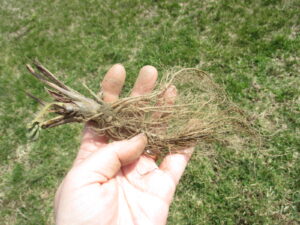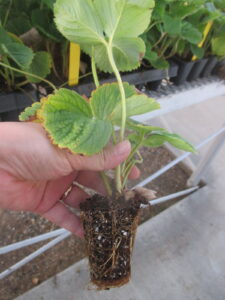In Indiana, strawberry is traditionally grown as a perennial crop using a matted-row system, in which strawberry bare-root plants (Figure 1) are planted in spring on bare soil. Each year, fruit is harvested from mother plants and daughter plants that are derived from established runners in the past year. Strawberries can also be grown using a plasticulture system, in which strawberries are grown on plastic-covered beds. Fruit is harvested from the mother plants. Runners are undesirable in the plasticulture system, and they need to be removed. The main advantage of using a plasticulture system vs. a matted-row system is for weed control.
As mentioned earlier, bare-root plants are used to establish new strawberry patches in the matted-row system, while it is more common to use plugs (Figure 2) in the plasticulture system. Strawberry plugs are usually grown in 50-cell trays. Similar to vegetable transplants, they have active growing roots and leaves. The advantages of using plugs in a plasticulture system compared to using bare-roots are easy establishment and labor-saving. Under conditions of high temperatures and lack of soil moisture, it is difficult to successfully establish bare-root plants. In addition, bare-root plants have to be planted by hand on plastic-covered beds. While plugs can be planted using a water wheel transplanter that makes planting more efficient.
In certain situations, however, bare-root plants may be used in the plasticulture system. This is because plugs are only commercially available for a short period of time in the fall. In northern Indiana, fall planting could be too late and too high of a risk to get a satisfying yield in the next spring. Bare-root plants are typically available entire spring to early summer. So if growers want to plant strawberries before plugs are commercially available, they may use bare-root plants. The second reason to use bare-root plants in a plasticulture system is because of cultivar limitations. Many of the popular cultivars that are traditionally grown in northern Indiana are only available with bare-root plants. If growers stick to these cultivars, bare-root plants may be the only choice.
Two ways may improve the success of using bare-root plants in a plasticulture system. One is to plant on white plastic mulch. Soil temperature is cooler under white plastic mulch compared to black plastic mulch that makes summer planting of bare-root plants possible. A second approach is to start a strawberry plant in trays with a growing medium, and then plant the tray plants in the field.

